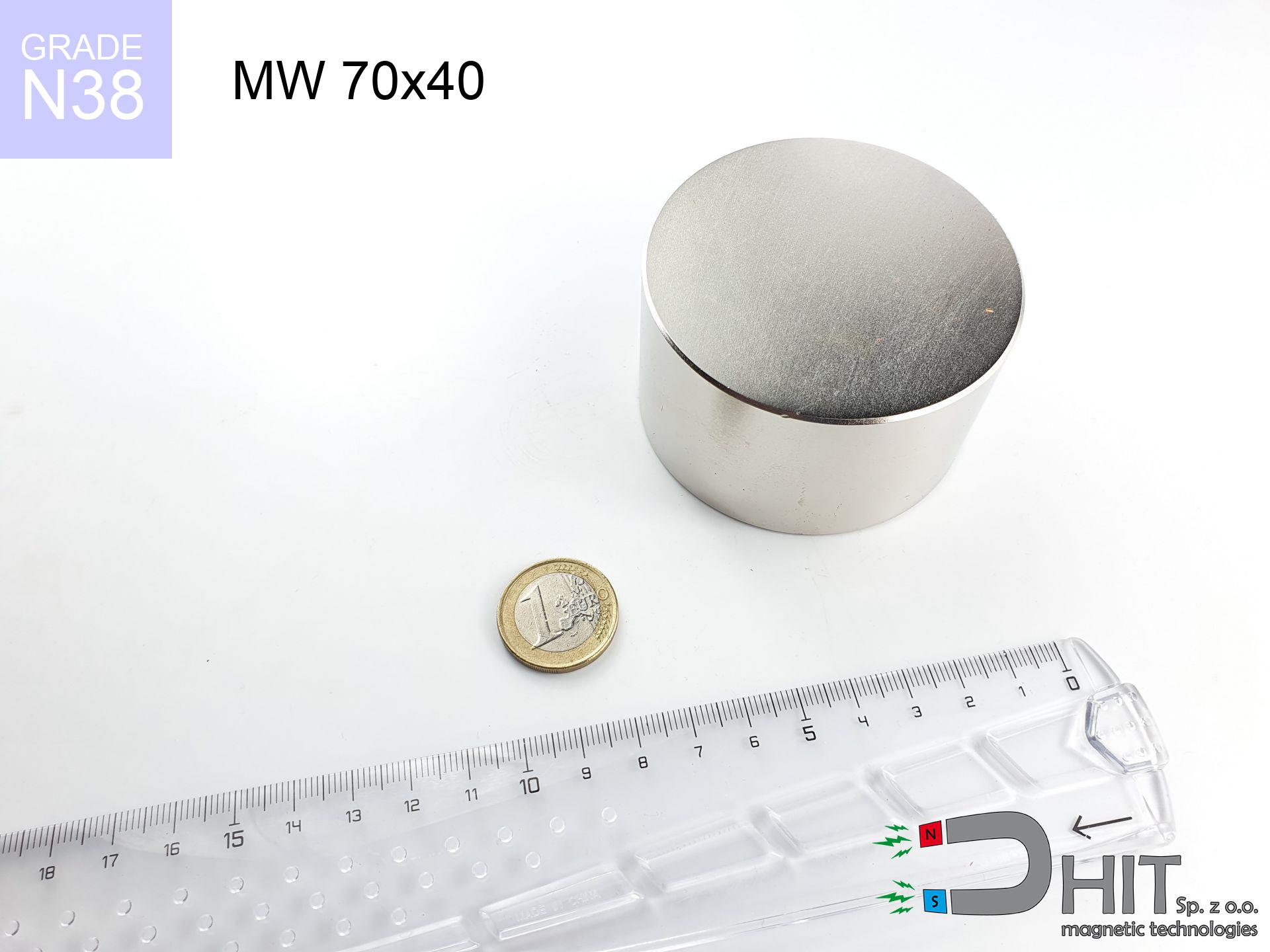MW 25x5 / 38AH - neodymium magnet
cylindrical magnet
catalog number 010501
diameter Ø
25
mm [±0,1 mm]
height
5
mm [±0,1 mm]
magnetizing direction
↑ axial
capacity ~
6.91 kg / 67.76 N
magnetic induction ~
219.99 mT / 2,200 Gs
max. temperature
≤ 230
°C
catalog number 010501
diameter Ø
25 mm [±0,1 mm]
height
5 mm [±0,1 mm]
magnetizing direction
↑ axial
capacity ~
6.91 kg / 67.76 N
magnetic induction ~
219.99 mT / 2,200 Gs
max. temperature
≤ 230 °C
15.14 ZŁ gross price (including VAT) / pcs +
12.31 ZŁ net price + 23% VAT / pcs
bulk discounts:
need more quantity?Don't know what to buy?
Give us a call tel: +48 22 499 98 98 or get in touch through contact form on our website. You can check the strength as well as the shape of magnet in our force calculator magnetic mass calculator
Orders placed by 2:00 PM will be shipped on the same business day.
Specification: cylindrical magnet 25x5 / 38AH ↑ axial
Magnetic properties of the material 38AH
Physical properties of sintered neodymium magnets Nd2Fe14B
Moreover, even though neodymium is a component of the strongest magnets, they are prone to corrosion in humid environments. For this reason, they are coated with a coating of nickel to protect them from corrosion. Interestingly that NdFeB neodymium magnets are about 13% lighter than SmCo magnets and, despite their power, are brittle, which requires special caution during their handling. Therefore, any mechanical processing should be done before they are magnetized.
In terms of safety, there are many recommendations regarding the use of these magnets. It is advisable to avoid their use in acidic, basic, organic environments or in solvents, as well as in water or oil. Furthermore, they can damage data on magnetic cards and hard drives, although data deletion using a neodymium magnet is not always certain.
In terms of properties in different environments, neodymium magnets are sensitive to corrosion, especially in conditions of high humidity. Therefore, they are often coated with thin coatings, such as gold, to shield them from environmental factors and extend their lifespan. Temperatures exceeding 130°C can cause a loss of their magnetic strength, although there are particular types of neodymium magnets that can withstand temperatures up to 230°C.
As for risks, it is important to avoid using neodymium magnets in acidic environments, basic environments, organic or solvent environments, unless they are properly protected. Additionally, their use is not recommended in water, oil, or in an environment containing hydrogen, as they may lose their magnetic strength.
Find suggested articles
Advantages and disadvantages of neodymium magnets NdFeB.
In addition to immense strength, neodymium magnets have the following advantages:
- They do not lose their strength (of the magnet). After approximately 10 years, their power decreases by only ~1% (theoretically),
- They are exceptionally resistant to demagnetization caused by an external magnetic field,
- By applying a shiny coating of nickel, gold, or silver, the element gains an aesthetic appearance,
- They have very high magnetic induction on the surface of the magnet,
- Thanks to their high temperature resistance, they can operate (depending on the form) even at temperatures up to 230°C and above...
- The ability for precise shaping or customization to specific needs – neodymium magnets can be produced in many variants of shapes and sizes, which expands the range of their possible uses.
- Significant importance in the industry of new technologies – are used in hard drives, electric motors, medical equipment or various technologically advanced devices.
Disadvantages of neodymium magnets:
- They can break as they are fragile when subjected to a powerful impact. If the magnets are exposed to impacts, it is suggested using magnets in a metal holder. The steel housing in the form of a holder protects the magnet from impacts and also increases its overall strength,
- Magnets lose their strength due to exposure to high temperatures. In most cases, when the temperature exceeds 80°C, these magnets experience permanent loss in strength (although it is worth noting that this is dependent on the form and size of the magnet). To avoid this problem, we offer special magnets marked with the [AH] symbol, which exhibit high temperature resistance. They can operate even at temperatures as high as 230°C or more,
- Magnets exposed to a humid environment can corrode. Therefore, when using them outdoors, we suggest using waterproof magnets made of rubber, plastic, or other moisture-resistant materials,
- The use of a cover or a magnetic holder is recommended due to the limited possibilities of manufacturing threads or complex shapes in the magnet
- Potential hazard associated with microscopic parts of magnets are risky, when accidentally ingested, which is particularly important in the context of children's health. Furthermore, miniscule components of these magnets have the potential to complicate diagnosis when they are in the body.
Safety Precautions
Keep neodymium magnets away from TV, wallet, and computer HDD.
Strong magnetic fields emitted by neodymium magnets can damage magnetic storage media such as floppy disks, credit cards, magnetic ID cards, cassette tapes, video tapes, or other devices. In addition, they can damage televisions, VCRs, computer monitors, and CRT displays. Avoid placing neodymium magnets in close proximity to electronic devices.
Keep neodymium magnets away from people with pacemakers.
Neodymium magnets generate strong magnetic fields. As a result, they interfere with the operation of a pacemaker. This is because many of these devices are equipped with a function that deactivates the device in a magnetic field.
Do not give neodymium magnets to children.
Neodymium magnets are not toys. Be cautious and make sure no child plays with them. Small magnets can pose a serious choking hazard. If multiple magnets are swallowed, they can attract to each other through the intestinal walls, causing significant injuries, and even death.
Comparing neodymium magnets to ferrite magnets (found in speakers), they are 10 times more powerful, and their strength can surprise you.
To handle magnets properly, it is best to familiarize yourself with our information beforehand. This will help you avoid significant harm to your body and the magnets themselves.
Avoid contact with neodymium magnets if you have a nickel allergy.
Studies show a small percentage of people have allergies to certain metals, including nickel. An allergic reaction often manifests as skin redness and rash. If you have a nickel allergy, you can try wearing gloves or simply avoid direct contact with nickel-plated neodymium magnets.
Neodymium magnets can become demagnetized at high temperatures.
Despite the general resilience of magnets, their ability to retain their magnetic strength can be influenced by factors like the type of material used, the magnet's shape, and the intended purpose for which it is employed.
Dust and powder from neodymium magnets are highly flammable.
Avoid drilling or mechanical processing of neodymium magnets. Once crushed into fine powder or dust, this material becomes highly flammable.
Neodymium magnetic are known for being fragile, which can cause them to become damaged.
Neodymium magnetic are fragile as well as will crack if allowed to collide with each other, even from a distance of a few centimeters. Despite being made of metal and coated with a shiny nickel plating, they are not as hard as steel. At the moment of connection between the magnets, tiny sharp metal fragments can be propelled in various directions at high speed. Eye protection is recommended.
Avoid bringing neodymium magnets close to a phone or GPS.
Magnetic fields interfere with compasses and magnetometers used in navigation for air and sea transport, as well as internal compasses of smartphones and GPS devices.
Neodymium magnets are primarily characterized by their significant internal force. They attract to each other, and any object that comes in their way will be affected.
Magnets will jump and also clash together within a radius of several to around 10 cm from each other.
So you are aware of why neodymium magnets are so dangerous, read the article titled How dangerous are very powerful neodymium magnets?.



![magnetic separator 25x225 [2xM8] / N42 magnetic separator 25x225 [2xM8] / N42](https://cdn3.dhit.pl/graphics/products/sm-25x225-2xm8-tix.jpg)




